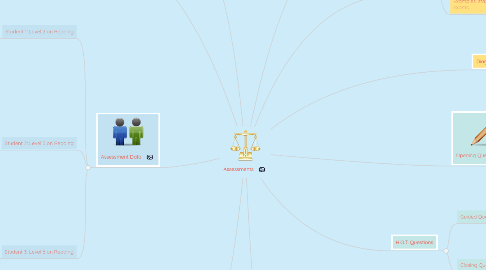
1. Formative
1.1. Definition: A variety of methods teachers use to gather evidence of student learning and academic progress during a lesson, unit or course.
1.2. Examples: discussion, homework or quiz.
2. Performance
2.1. Definition: Assessments that require students to perform a task rather than select an answer on a test or ready-made list.
2.2. Examples: open-ended response exercises or extended tasks, such as revising a poem.
3. Assessments help students learn and teachers to improve their instruction.
4. Assessment Data
4.1. Student 1: Level 2 on Reading
4.1.1. Phonic Approaches: Student is not able to identify letters or letter sounds in order to form words, which is preventing them from reading. By practicing phonics, we will allow the student to match the written letter to its sound, and then advance from there to form full words and eventually develop reading.
4.1.2. Modeling: Student is not yet able to read, but if the teacher is able to model the reading of level-appropriate books, and then has the student repeat after him/her, the student will develop higher reading much quicker and will not get stuck at one level.
4.2. Student 2: Level 3 on Reading
4.2.1. Sight-Word Recognition: This student is not able to recognize written words, which means we should start by going over the alphabet with pictures and images to help the student identify the letter and relate it to something they are familiar with.
4.2.2. Constructing Meaning: By choosing a text that is meaningful to the student, the teacher is helping the student be more interested in learning, while helping them with connecting prior knowledge to new content. Since the student cannot read yet, they will love to see and hear content that they already are familiar with.
4.3. Student 3: Level 6 on Reading
4.3.1. Individual Instruction/Reading: By reading one-on-one with the student, the teacher is giving the student the confidence to be able to read without judgement from other students. The student may read at their own pace and the teacher may recognize more easily where the student needs help on the most.
4.3.2. Small Group Instruction: By grouping the student with others at his/her same level, the student may gather skills from the other students and may share the same struggle which will make it easier to target with a partner.
5. Opening Questions
5.1. By looking at the title page of the book, what can you infer the book will be about?
5.2. Do you think this book will be fiction or non-fiction? Why do you think that?
6. Summative
6.1. Definition: Mark the end of a large period of learning. Used to evaluate student learning and academic achievement at the conclusion of an instructional period.
6.2. Examples: standardized tests or final exams.
7. Interim-Benchmark
7.1. Definition: Periodic testing done to determine where students stand in their learning process and to know whether they are on track to perform well on standardized tests or end-of-year exams.
7.2. Examples: chapter tests or written assignments.
8. Diagnostic
8.1. Definition: A type of pre-assessment that allows a teacher to determine the student's strengths and weaknesses, knowledge and skills before instruction. Used to guide lesson and curriculum planning.
8.2. Examples: pre-tests, teacher questioning or interviews.
9. The process of gathering information from multiple sources in order to develop a deep understanding of what students know, understand and can do with their educational acquired knowledge. Used for improvement of both, student learning and institutional practice.
10. H.O.T. Questions
10.1. Guided Questions
10.1.1. From what the ________ has done so far in the book, what do you think he will do next?
10.1.2. What would you have done differently?
10.2. Closing Questions
10.2.1. Did you like the ending of the book? How would you have changed it?
10.2.2. Who was your favorite character in the book? What did he/she do to make you pick them?

